Toronto, Hamilton and Buffalo Railway
The Toronto, Hamilton and Buffalo Railway (reporting mark THB) was a railway based in Hamilton that ran in Southern Ontario from 1892 to 1987.[1] It never reached the other two cities in its name, although it did have branch lines extending to Dunnville and Port Maitland.
 | |
| Overview | |
|---|---|
| Headquarters | Hamilton, Ontario |
| Reporting mark | THB |
| Locale | Niagara Peninsula, Ontario |
| Dates of operation | 1892–1987 |
| Technical | |
| Track gauge | 4 ft 8 1⁄2 in (1,435 mm) standard gauge |
History
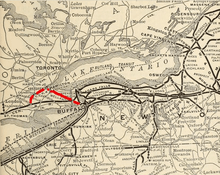
The railway was originally chartered in 1884 by the Ontario Legislative Assembly to run from Toronto to the International Railway Bridge, connecting with local lines to Buffalo. The original charter forbade the company any attempt to merge with, lease from, sell to, or pool with any other railway. Given the business conditions at the time, this turned out to be an impossible condition. The original corporation was unable to complete the line before the original charter expired, so the government revived the act, requiring the line to be completed by 1894, with a new group of promoters.
It began operations in 1892, when it took over the incomplete line of the Brantford, Waterloo & Lake Erie Railway between Brantford and Waterford. The line reached Hamilton in October, 1894 and Welland on December 30, 1895.
In 1895, the Canadian Pacific Railway and the New York Central Railroad bought the TH&B.
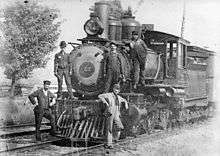
The TH&B was jointly owned by the CPR and the NYC for several decades. NYC and its subsidiaries (Michigan Central Railroad and Canada Southern Railway) owned 73%, while the CPR owned the other 27%. It never built into Toronto or Buffalo, but used its parent companies' trackage to reach the two cities. Passenger service on the TH&B was discontinued on April 26, 1981 when Amtrak's Maple Leaf began service. In 1977, CP Rail acquired NYC's portion (at that point part of the bankrupt Penn Central giving the CPR 90% ownership and destined not to be included in Conrail) which held a 10% ownership, The CPR merged the TH&B into its system in 1987. While the TH&B line between Hamilton and Welland is still in use, its former line west of Hamilton to Waterford via Brantford has been abandoned past Aberdeen Avenue in Hamilton. The portion between Hamilton and Brantford was abandoned in the 1990s after trackage next to the Grand River was washed out. Some former TH&B industrial trackage still remains in the city of Brantford, although it is now operated by Canadian National Railway.
Increased operating costs, and tighter profit margins in that decade meant the future of the railroad was much in doubt. The TH&B Railway was merged into the Canadian Pacific Railway on January 1, 1987.
A portion of the branch of the former TH&B railroad (CP's Dunnville Spur, built by the TH&B in 1914), running from Smithville to Port Maitland via Dunnville, was abandoned on May 7, 2001, when the Port Maitland Turn made its final run between Smithville and E & O on that line. Trains were redirected onto the former NYC CASO subdivision, at Welland, to the remainder of the Dunnville spur, via a new connecting track.
Paint scheme
The railroad's yellow and black paint scheme started being applied to boxcars in early 1952, and was later applied to cabooses in 1954. These colours were chosen in honour of the local Hamilton Tiger-Cats football team.[2]
Railway stations
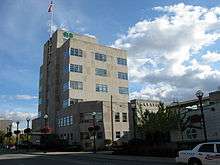
The TH&B's second train station in Hamilton, built in 1932-33, was in fact the first building in Canada adhering to the International Style.[3] The station was refurbished in 1996 and is now used by GO Transit for both bus and train service as the Hamilton GO Centre.
The TH&B's Brantford station has been converted to use as a restaurant and has carried several names since the first one opened in 1970.
The TH&B's Smithville station, built 1903, was restored in 1996, and is now the headquarters of the West Lincoln Historical Society. It is open seasonally as a tourist information centre.
The TH&B's Jerseyville station is now at the Westfield Heritage Village near Rockton, Ontario, along with preserved TH&B steam locomotive #103.
Perce Hankinson
Perce Hankinson, who began his railway career in 1917 with the Michigan Central Railroad (MCR) realized a lifelong dream when made Vice-President and General Manager of the TH&B on June 7, 1965. He retired 5 years later after 53 years of working for the railroad only to return to the TH&B the next year and spend another 16 years on the Board of Directors. Hankinson retired from the board June 2, 1987, at the age of 85 after 68 years of railway service. In 2001, Perce Hankinson was inducted into the North America Railway Hall of Fame in the category of "Local: Railway Workers & Builders."[4]
Diesel locomotives
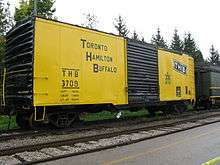
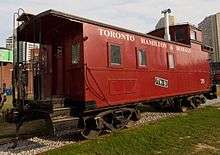
The TH&B was one of the first railways in Canada to fully dieselize. Starting in January 1948, the railway purchased four NW2 diesel switchers from General Motors Electro-Motive Division. These locomotives were numbered 51-54. In the fall of 1950 the TH&B received an order of four GP7 road switchers built by GMD in London. These GP7s were the first Canadian-built "Geeps", and were numbered 71-74. In December 1950 the TH&B took a second group from GMD for four SW9 switchers. With its switcher fleet complete the TH&B looked to add to its freight Geeps. In the summer of 1953 the final three GP7s were purchased from GMD, and numbered 75-77. Still needing to commit motive power to the locomotive pool for through Toronto-Buffalo passenger service, the TH&B purchased three GP9s. These three locomotives were delivered in early 1954, and numbered 401-403. This completed the railway's diesel fleet, and the TH&B did not purchase any new motive power for the remainder of its operating years.
Cultural references
In his song "Under a Stormy Sky" (from the 1989 album Acadie), Quebec-born singer, songwriter and producer Daniel Lanois pays homage to the presence of TH&B locomotives during his youth:
"I hear the T.H.& B. the diesel turning, calling you and me to the city of steel, smokestack - spinning wheel come with me Bebette, oui under the stormy sky"
See also
References
- Helm, Norman. In the Shadow of Giants: The Toronto, Hamilton & Buffalo Railway. ISBN 978-1896815008.
- "Freight Cars -Toronto, Hamilton & Buffalo Caboose #70". Toronto Railway Historical Association. 2001–2014. Retrieved August 30, 2014.
- Kalman, Harold (2000). A Concise History of Canadian Architecture. Toronto: Oxford University Press.
- "Perce Hankinson". North America Railway Hall of Fame. Retrieved 20 December 2014.
External links
- Toronto, Hamilton & Buffalo Railway Historical Society
- (http://www.canrailvideo.ca) Canrail Video Productions
- The North America Railway Hall of Fame